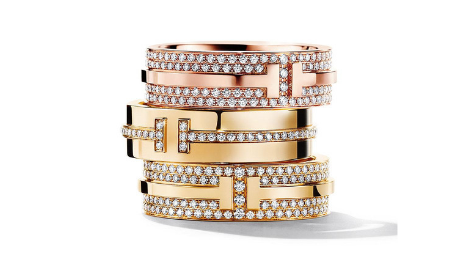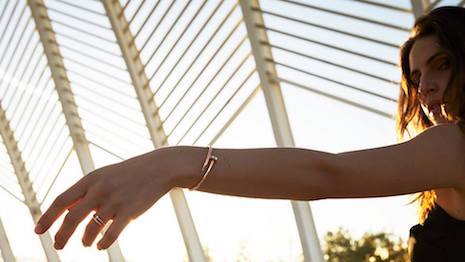Luxury watchmakers and jewelers must continue to invest in digital marketing and ecommerce as the sector stagnates, leaving opportunities for upstart direct-to-consumer brands.
Resellers and gray market Web sites have thrived as sector leaders have been slower to navigate today’s digital climate, according to Gartner L2’s Digital IQ Index: Watches & Jewelry Global 2019 report. France's Cartier and U.S. jeweler Tiffany & Co. are two of the brands that have outperformed others with their digital strategies.
“The watches and jewelry sector remains slow to change, but are slowly coming around,” said Brian Lee, senior principal at Gartner, Washington, D.C. “However, this slow pace of innovation means that threats and third-parties are filling the gap online, making it even more difficult for traditional watchmakers and jewelers to compete online.”
Gartner L2’s report evaluated more than 80 watch and jewelry brands.
Digital acceptance
User experience is of tantamount importance, since 80 percent of affluents research products online prior to completing purchases.
Monobrand sites for legacy brands, however, have fallen behind DTC brands and other digital disruptors. Half of the brands evaluated do not offer product sorting options on their ecommerce sites, and 16 percent lack even basic filtering options.
While the majority of digitally-native watch and jewelry brands have on-model imagery and live chat options, only one-quarter of index brands do. The absence of these features means the customer experience as a whole is not on par with disruptor brands.
Instagram post from Audemars Piguet Golf
Ninety percent of jewelry brands are increasing social media efforts this year, as Instagram becomes the top way to engage with potential and current consumers.
Twenty-eight percent more brands posted an Instagram Story in 2018, up from 69 percent of brands in 2017. Almost four in 10, 37 percent, used Instagram’s IGTV video platform and 13 percent created stoppable Stories.
Swiss watchmaker Audemars Piguet wasted little time jumping to leverage Instagram’s new long-form video feature, as it hopes to establish a hub for golf fans. The brand’s Golf page on Instagram shares content surrounding its brand ambassadors, with high-quality images, videos and campaign content (see story).
Richemont’s Cartier topped the Digital IQ ranking, with a score of 147 that earned it a “Genius” ranking. Cartier has improved its ecommerce capabilities and streamlined its mobile site, and also boasts more than 8 million Instagram followers.
To promote the launch of a new, slimmer version of the Juste un Clou bracelet, Cartier created a new campaign film. The one-minute-long video was shared as shorter clips on Instagram, while running in its full length on IGTV and the brand's Web site (see story).

Tiffany's T diamond rings. Image credit: Tiffany
Tiffany also achieved Genius status with a score of 144, and succeeds in many of the same categories as Cartier. An increase in social media posts about sustainability show Tiffany’s solid understanding of its well-engaged audience.
The jeweler is taking a large step in revealing where its diamonds come from in an effort to be more transparent with its customers. Tiffany shared a short video to help promote the initiative and bring awareness to more of its followers, which included its iconic Tiffany blue with various animations (see story).
Luxury movement
High-end watchmakers and jewelers can also find success by partnering with online retailers and leveraging their better developed ecommerce capabilities, according to Gartner L2.
Cartier’s men’s and women’s watches are now available through Net-A-Porter’s Fine Jewelry & Watch Suite and Mr Porter’s Luxury Watch Guide. This represents an extended partnership between the retailers and jewelry house, which had previously been limited to temporary pop-up shops.
In the past, Cartier has hosted pop-ups for its Panthère timepiece on Net-A-Porter and its Santos watch on Mr Porter.
Now the brand is becoming a full-time part of the platforms, adding to the growing list of fine jewelry houses that entrust ecommerce to the retailers (see story).
Luxury brands have also attempted to move beyond traditional timepieces to enter smartwatch territory, but their market share remains small. According to a new NPD report, Apple, Samsung and Fitbit control 88 percent of all sales, but companies such as Fossil and Garmin are hoping to catch up.
Younger, digitally-savvy adults, aged 18 to 34, are pushing the market, making up 23 percent of the smartwatch market (see story).
“Brands need to pick up the pace and invest more heavily online,” Mr. Lee said. “Move beyond traditional advertising media and create social media content that is specific and tailored for the platforms.”
{"ct":"xthQhMfLzA6\/zbFR1cpzdxVQ7E0pSYgOafXf4vkM+WuUBwrScU95TPopdv6U2CcbNtrAaf5kwFpgOn2TqJcqcvT6Y0\/mFikA6dXtA8+lYfogMGJkUbVDHIEmF7Nm8RKjzIKyBZeL\/vA1MZe4jOD3nswwFMHt\/MRjAisPPbCjAjk9F0rB2rJHt90ZcFYbBCSprdr2Hg+UDRTCAzLS14e4XJjswexVBvHRkOVqmUaW+IWIFGkc60lZLtZvhVvRCMG9y81ek59voSVpFklORj4R2v7hmTbTLw3Emr\/NaiQbgABUkYPQ3SurmdWbvHb24tuhNr23NFf4GhY9i4vRMj8NXe6LzZuwv5j63vZ8UCtxLcbvvdD7riW93+u022gD1fj6qGjjHwUlGxY37RUleoMfPxdyfIbZwLwVT0auci7WoHmhiyIKEMThoJLxcuy7dcAAZcngM6DAJlipUE5nFlGoVFmpzLfH7u95xXzPdKgwwfS8Ee\/Xc2klufadkdPTdI1UMtcrCsDb1SMvD2oecgcVM3nR7GzMsmQsosryz19TynlWpUZ9kqHW8+wtKdqqkfYKzMMXTz44OKnci+iygp78KvKQWbccLTmeuIhvasAB6yBTge3NAAdIOEZpGJxGfBdx83ll93BsEmOUYGEu0aabB86jK2cCIoxOd5wCtw9ngDMBhHqOloLUKPEBEKsUSzI2TDRiiJcBu2Uo7GOBAJ+2Gx3Y7opan\/8S8tFQBZ8AVvqYI8lR+Hjxj8DeDXBA9YoqD6bYEDzk7RmoEBmQs+eN86FM2d1wJ6r2DaM4SsPWZGfPMObor\/pwqFr3pWC4ZDWasv2y\/O16SmY0C+DAnFTmzgc7AUdV3hjfFyBJeOIiNB8aBRPTYSiRWjOmGN59H60W1froY2YsKO2+GNHrJCbnxWZkoNWlWdpFWkEmd54Nk3mmfREzEUPe3+ddMcwtEUELtGHu09pPGebRZaHcmfQzSOx1dQzFfKwh+Da\/Q7pRqqtnCsUSBru1nd9+Jbj8Fl6GzbQ9XIa99KQc9xCSzuIz6cPJN3UqrEig5XmVHLCP\/auJA17hrEmw+cvbQkX7mM5xmjUWKxEs2N5qY+IHFM\/qxkgqkkHJbIhexR26YgEXxzmLd4AqY\/bEAj3ClORktaMcj7FA2bkre+MrAWCUQZ8knv1MaojLpS5qa0bZp9O\/9eWuNfbPqfQZAwB8sts\/6I8KjC42rwOCNxRqsA6USInoZkK0MOkF4V6YATEabpSJBNNrp\/okTA8JppLU\/hYV\/0jt3M0lRniFzmGPJE8emB5ClufAYPDtKAMc4mu8uztqewvQlls4Cf1IqRb6iic2jqAMkSRf8XjRh75uaivb08A9JbY3e5pfVEnKqEIoo0jy\/RGQx7H00gExMZFX6ps0UCXM9xwvvz4EkzBUf\/1FVxQNBX\/UEGzsIw7u\/CBhlZuPgMHsqfbtUu7RXkHuZyn3One535pYVYeyQwEfasVtO3bPSruIP+vaGFtbeByafaZkwhbLWr1uAfwC+Ar1WoilvLMX2Fkt5JnYTTYrCzgKV\/Um0hxek7pMSmbd8BBMXEBPxMQ9rEEQwSaBfyp\/7TEM7Mas6RulWc7bbGFpMlFwMNW7IMjjSZ9XrJHyStcL\/2abMSUSwaGfd4PMzgPrSn6f9LCmqwvhvGyZ99uIK3MffVdvIxkHW4klW\/K4PLEqIxyC91JhXn91BvYHfO6f1VpHIsfDOvIEyvxJaG90InuNQpqUzquy6u00PUGE2sLosSm8Txn9wvSqd9cy8WfIgVaoXyh3LLGgFuTGh8Oljox2PemQoSqHh7z45Po2jqBuMyblRp3mJnmLAmDsJs5jXEP3L5LQQWLRZBwdbzv0IZbckAS08Q4+9ZsnuA+0kjz1Vif90Bhs5LaYk29FLajhTO+AemMFghk5bRsMDUF+G68hCG9UA\/p0aDE3y9QfSFX6pc3ZStP1on8rUtGr2n5WRCkdLizUwiR0AwwCETwTItjsoqceJpJebfH1RS4aCx3GjFVSn8YtHSN6xqwqZCXmAbDvsAOcwkDn+oUJYJ\/jQrHNHsTnjv\/l366ydImwZdZlEmHdQ57lNbswpigxWgYy4ZeRCnSjWTy3JWnMG14dB758JHgiNsfLxzxt+rijkwDoHG+l8nNkArNrdFe+slM\/9jtEYoFi3BPK+nzCm136LtxbN6fAkQoPwweUR6glImJDCprlYbr3LNzryL6Q8lXAopbBAfb4h1dv3PI9H0WfvhuYYPyklznPhXHb1W3NyySs8apwUeImuckozuwYqv9zVRGdqDTjT\/7LiQHAwALb6Ul4sKKFu\/I0cRubOOTq6V2FqlU5YGo1QteMtqP2PTJvvWvcPP4UiqwgnB8VsZKKDMXY6A4RtmQ6lCVL5KIRPGjwwyEGcrKw6jfDo3HbPItuleMY3tvuh7TWdbnuWx2dyXVNRpkSieaGXxXh8tMbaAmEVnkh0YNQprnzSZOw0Y9blJ0b0GGhMAx99xwmilzYFS\/0aWv5w5mVpG7GZ+eNujM+7pk0BkOnpiR850GVsMa8xwjpFHUmRjeH4hd2jDRmy\/2TvrwEgnYL8lHxsyfkqGRunLMmtIvNvpPkzct6THUCd2ebM15TWARHf8ALPkAWEisQwfB4lwgxs+anUFQiVsDfgkWqunV0Q+mbQSW0KJpxaNobZjY\/pH9F6Dv6hGafDRQRhHS\/jKq4qL9rPv1APms9jdgwv47AhrmMgfxaqtIHWih+\/J48beqQGr8kx2v\/ApqGDIo9nI\/XnTnPu5FnLw1oFB57\/WVSvFWamJCP8KXLA20zkwaJxXglj70ebKUuzU+7nxJaFEECmewZaaFE3gqYAOUXtjWr61Vi7jaK9XFstnqY6kH1i6rgKGbdZQFB3BRMJHAEkpcmyUcvU4HXN4ypsIsf9wmum2X8lErcgrthPAActNLva3qFxLdIVsGomn1K\/h6MWMSowTHUEG91\/zGRHHbvVMlGXK23Hv2Lc0Q4PC8XXg1vV8ko1ay05U5ULcf0wFzMcPTLh6SAl9IVeb94nyP0zmYvuabC3TrCPDR3lITQGBCPxnNpXa91+hplQvO8i2w4nN+kE1gfhDUXjamsj5n\/GGmteZU87chX0ERqh4ubz\/wQaVf+nVX22oO8W8ehb34R3DvXj9BAaft5ncz\/X468VloBOULHgvzk4dnntuaS9Ntj4iD5skRI9qxuGpfR98XesTHBfcyh6XCd4nAblnLl9V5sDJKO1WkozqbkEXIhMd+mIKh4Zxib8uZqcQk3nvzSwpSSISKVl0izPff7LBvPYMxw1djv5g1DRNuHjkLXXyi52eM+0s8b\/sooCpbvJM6Ci8P08DIH5KRMjXxan5bSmk7OaDfuB\/H3oDhXCuOU4iDRSARSocFzP4EzBGvfB4ZkXnsmLrCm6U4CZzisH758pRLtCa68zXdJ9peQhSLOGekYOk6Yg5pHDDhTRT\/qaS0v5mNTBWU92\/ugLYeVxKyFcVnfcmWm51ArJNgVnUI\/UWGw7lgVCR2NQf76JotmGacWUkWUjAmwGdR\/Z0Y1LNqWvX5Q7ltn11vQp4lUL88kISPbrWOr\/ZXZ7+SQRo\/9\/H5Rj5lxVRnfD6JzLMF71DpnwCXBsDhOl\/QyLlgMjJdahZehyGaQcPm+Pwt9IaL82Pl1qF0QeHCfarskUh4sP9GeeIO0imVy8Zf91DOdNIb+FZjE9oMI8hg+E9Gmg8ta0qrtVLBwwmhN82cAioORyJHaLajIa\/6LJ4SqRpOJB7wlf1yreg8yd+6zBjvmKVlsbtBXlFi2HDxvDl+na13Mhp9OC5kGrADzmCQ0l6aoo9V34S404N1B7843f2hofyYMWZNGfZg25I7Ojt+t5aPfPXoAMU5WY062\/UWiZbDMCLB3MHo9hjJu9uD1fUvayzWa7HOmGek4SkSr01wVwP6pU+ykQM1g2cPtDpt0drz2EpLTJy90DBz9xQoj6RMeeAqKtwBZ3BMgtL99oCIFgjU4Sv2BxpGPLpcjVm+GM+\/E8af3tm28u+YmFU5bynwldK+EVM6m9VDfaQUc3E67vmo1ILM6KhZKtVNTI74Wu2cK09+WofMYCGi7FimOzHJcbAdk5BvAgS0JCTPSbjRJk8YhNa2UgjV9z735hI6VeauaLs\/uSQ2TaFoROP+ZE66KkKWtDei42EV0gmLtAtjxB\/EVS3CfSQ\/7IWH2xDEFDcsRljQNIMp8oGLsyD+ws0oqDGSN8yJwXWTHmmM70LkIDeDdLVcyGDRVIEsyRaSm3xsfQdGEBexU12g4H+Y3PKkg3\/dJjtslw6VwIusIxSZsR1ADFaNb\/CtYW3byGiC+LxSaIoOa1MAk2nDkuYzW0QNAGaIeWlYxuyWSQxsnJAtgBxHwtoW1Py59I2BfjBU7F0gJGZ8TsoGDxAjhEDQThFPQz1kCQyqE\/YF4FUuN8GE3nV7ae2z9UoiSAc+ey9+j8+8rE1cgbxcrgXb7pg992c0fHNi1x1mai4o5bz\/G\/d6trXu91Aqz9juOs1\/kxGiS19js\/P7POXf4TRcpyj+6HWg1U+luRSTYW+7PIEV57N77ApJ\/t89R9kuHpNepCkIizPHswnNXW8XMVKB1n6If5nEGyg+8b\/+ia0QDLFCZFM74655nGC3bfHRkjqU8ciNLutyTgcr8GS9+wwFHc5jGfmdhyzONV8GkImx6mG2bivQZ9AoDcWsQ0yjfMyzspW8V5Fe6AVFvZZCA6X5WrOpKdS77CVl5pwUPbHNDuhLlBpQbpkXlpSzsTcEBkqU91ESjvsSNKWxJShCjw2AXcHd2\/kyN4GXR+EO7C0ifU0IZlcjO88r\/aBhlLrpuw5Dkng97CZGfw+xNKgI+u8WPuwXo+nty4oUfFDpfA82YDMMQ5qBea5+dKjL4Czh6pVgb2OC8aS2Afk6sNXL7iCCTI1Yq7bbtCIP1FXrncSyMxelEi8g9EvmeXGirryFGAU9wMtOrwo8edikWRkVj1REPhpKJ41sup4rK\/0qsq7aIOqDGdMsXLwA9evicxkPlsDNvQahMf4PpNNbTQ1w\/c6bgQX5ZsZf4wH72M1DE6wVXNgIFR8PwP1nEOJxi\/ekALstObbxG8hY2mqG4V49sGEOrbFoOfP2Zq2qumlhssHwpVcem\/sMpXVplmlSS\/HcCYN4qoTPCKV0IWQ2dwcQwfvWVAXci+ujpzbkA5eKixPnnwBgIxpqGtUOiyrHDQosDehduwAA1n7nxfeN2BHIEq7zI97GaDMKX1ZhJMEWGAIYRSDmA4SevXlkCrb6vs3piE5WzMDYTDzjCzXt092g40cpkLnty+Ut99Ao4PvSovXL062zaPpNr+X6LPqrmrNtA92EewF2cB7iEmzKhC9LN9n0wwLyPwbZyUUe3NORSHm+fAy01xikcdWZUueDVDMi4WYTvTwzHuhYs4PWIHrh\/gETV4zg3RXdluTcNmh5FBI\/dBy\/p7HM7V+Wf79gBytPf2MxrzTcWJBF\/JTpDiSp82Ya4bo7GcAaXzhDcC97tslfqnORKLskxEG+vqQjR+SoJYejBSBlz0dNJ8VHVBY+HLfPHL9qwA7FS5UlObnmp6w0gPUNQUrk5haVn9d\/MRabwrTFW2XgmgnjQPtsOUyF3NUOgbUtwaIkEDWHygyNZZYW22olbaUF1rmtNkdHSE+Zl+d69lgBh1Ef1O+r5vR8iVueRe\/8CgJKcQ33l25x+oKy\/7LEyMl4qy13aWPVrdltbl0AZtS2mQbRQ3mYgbJ8Dqd7jiUG0lAMKND69e7lJCfMQBsDGyK0FP\/KpKY9T65egdWPtdlchH\/V0jwrqDY07a8Izj3wCPrQBLk86SyL3WOC9Tzsm4sWquFENKul3vFDom2B+rxkc+QTX1usjfAeDgtnup\/Fxvl2l3wJafrSzOzi7qsJfzxpMqByJj9\/8h8RMXcrTmkfpa4huand9gojUAjMOhtVM7TjC2pJRGt0LfldxC0gjKZkw7UwOKjZgeWfXSjbEm9fDdIxvIphyMiKwMs+WuK2BVkZ38v06+T11pw1Ms1n\/EvDW28h6FssAdKM3tNfh76N2V8LdwCw+mXn2UsYXOsQLQhWphvRPFCu0KASp+MN13NVtIP7\/Z\/zINHl9gyGc4yhAlpBR+SMaOMUTDoa\/2xKGLFI0FcFdRMC7LU\/GiwDkLRH8dGSdbwO5VdroCm69\/l0PsHec+yhJ78UoX5YX3ICRpYjnEeCGjq8R+n6f\/JojhhkuOAkl3EBdVzh1UVuTLtwN9PdYp4I1h9e7WPORrs95Z2d6LYg5el0IMoXNf57JHA2xz+syvpexcC8Ikyhd2dxz1Kf\/VC4lPdyfqcVfEbUXE89OqBNjDv9qAgvSBHINRp6tRcA5bE0bwRnmx9E8ywFmKILMpAhOJvJPEGN5uwH082I367cltNQjCdB6ThzgGxw0qtmZy4dtfjZ6aCUhp2cYSjOYlKJeXP\/3ilYj0YNnfgzMnfFM57KJjbfhegtVlye19WKFw+wkRY7Tljiuwi4kcUytHRz+Vmm89MFx7V1eWlgATQa+iZlpl1lli\/VrihIKOfxTk8Sej7KuKsnNhNgxsnVVn9QKRDYYnFsP\/y1IlaL8hbEZmbe2s3AwHlkwfUe3YxOVSR2DnBWte\/NoSGiesrSVK7DmRwPIoxu4Uv5FTDXBsa55NaGikBA+0jGHGLPAT\/Cz5jBONt0m5UhNEhAYNv9K1sbkvJt5RVkAynlzBPRERC4h83yHsKkkJ\/sW8PpxaK\/6A0EEsJ0Gpn5YPZWVszZ8YoFbSNGF7L6FmjQtmdjwoY8hPz84bxKHcaEzMM3I2zDbYWi6kIF+yHqTuiW+pGYR8uJWrSgzgCvp2dca0EWyLMX2c09DoYO3RmPUEI5tEFHGS6FmHE48Pu1phWOQEEv69LpFyNTLElCoGvzZ8NNGH07WmUMX4Mu8G\/Vgh2WxKLEhGAfEJ3MTeKXSx0SAbOXNUfwIksSMCBubF4JHUljFgYJLQNw9qJHsQ5a0LCZtPDNEPF4x8O3ubXcHESMW9HhE+NyofVgtgx4x0mXdt31u2rlc1l4+SEBZh7Xy9XBuMrXHZ9VFb6s7i9WYpx8SQ5uoYA0uqb\/4muNaUislnqCCGB62tafhqvS0V0qIoiNBHOLtqSWyc4F7bEdJKtN5jgjaLRKJkNWFAjDVZj4zdiPPQdqRs6AFD0mv+zkOh+8pAjaMerpF0eMZtoJwHVqKfhfCcLDdNzY5jcvFi7LUFM2Rz8h6Z2bFpZ87tvLfVCms46gWz3odGP\/EmzdWlR8aorXKt1RNgOq2z\/PLukqKEWw99\/BgaKMnvAS7FeZA3XEohFge2\/H5MxPvAdDk2yZ9tTbjdsrfIlq7y8vNo9XcD4Z6LdMxJiQoTcVeTTgXmdvCUgVQMFEKyXQO\/zU6YRBYAYwnWAjIpUNJ4AheFE47cBzuVEZ3\/rnaDtNZNtfXUYD5QJ+kR9Pyuhh8CJH1kh7bV4v7UjZJoera8NhlMFSNNa8Cd414ihBiX7Si1L3sx0RxFKGI7jy3Q8z8AerFBQVO2kNdPg1kR5esoZsng\/\/B1D8VjU0JYUDlWaWhExdjWbnFZdf2BO3WYN6TgTc\/ApVJBVeJRpvXft1iJaBgVBr6nSMJqQkWH2MBuL4q6MFU2osd0WlADNvJb6dgzc84o+umRCcF\/HKLeQHpRDXZYtJSoQKNGLhtsRXvuzZa7wEa9u0eCoyhzEfYPvYskDEkoPi+S+nc86ojJrl8hNdeZ1aIuR3dFJIKGWdpRZBP4dZJmfmAwIwql3jq7BGhSGdncvn7mzRMIqzlJmW+eNb6qNZPjdoJLF6RKAUG3pBcaxV3z8swcu3VLwliPAviZIekV23WJ7\/aMtmXO21vez6qMHTwvIq8iLf3UffIecO3W9prfmoeBPmiSAd5DkvXQeZ5abB9mUyCzVOKlEDMPc4T0vYRBhkbX\/heRgDQPCMd3DSYfJRRG8ACnFfBVxYFvtKzQY6MYOKFqwUQxQfcgwToZWbceLBHIibyeWLidSxVEUY9arUjY\/APo2bPjQr8oIV2YoQgNpzgekg\/yfD9\/ACgSe9l1wntFB18IECyUfMWj4SyIGdJjvSyDwLZXKqI0xAVqvTHqCmHXgdlGeTpYKZfZWI2RmBobMfmlIaVV3Xw\/m1HA8n6jYkiqOnNMUq8E\/z4wloMHewvBvQDHigfQNQ1NLJ4OIxAK36g07A7WgXQeHc3InXIeGd4aKHIo10VE8XxG6KOsdC+IL8raFq3bpIS6EUZwoy2KJHWY2Giep1PrVMl\/M7oJdEZ9m+PJ\/zHtic6GNyJd9BQmY71Gcfa2PBRG2Tsv4LbUBm9aoH1ewTULtTfjT7vMTf1Zmr+pxN2nw75XioQf2vo68goYayZGjom7oPDbi04OOWGMURAuJFn6HRW8CL5A\/z8QQCrscXxLp\/2TY8r7yy7JAasz3gLSnTCVlPU0nHsqvD19aB1xPx1yug3BlnqLY0tk4Fo+DkXQhVEYTUqwyn\/LbUCWQL\/2Vpz5I4ThyphjcjOAiki3D4wimz6ZHdx2Dyd486TSmMLr+6jqlaQ36t1HnbZxBV2TIjAMtX7\/Hnh7ipTq+OgkOJVvEpWjR1WV2ip91m5LY7bNBt3kLr5Olx1SekJntWLyn4M4aiK6aH32bOuAdA0Q2x\/RngQ7QgBIny35v+qdpBYApqOmhtUQNbw8tvQDIPjsHlS++YjY9AJpBlTMeyM3WWEO0RIXpDfsWrBg05jZffg8qInB3MEkh5SYkcLKO065r4mzLo3RWHir\/Ei1Li\/+A8CRxhNN5Q8iZqHbmiJacyxdfZ4MSvWUerB2JaEUBX\/8E1HGd7O\/oNvsye3eubLjG9ys1b3OB73OWLBq8zyNIw7XA56QzJr62BxkJ+64r4x8BuZxSdbM0tS4vWFa9KIy6SI5zPCLnOaq3BoH\/6X6LoqvRKmWXg1irMYQqx+Ya6ZKgeAOS\/sK16Wi3\/mIFVHjEn4JH4Rh5LDGX2emhDZJjIvg2xmr+nlIrguABZ14dSMPywHvjB0QHAkoydAEl5vZUsItVpAC8LAiQbWUS9U6i+piAqJMIDqWn0DuPVpmLxV+DCZM7UJcwW7r9XMzvnaznuuYuhccqYuQ+oZcolTOJC4hQ8kcM+6eUEPaY3HwSVmR5oxdo31QUhes5fReP9qmBkrOtrEao14Wl4I6F44Rw3wS8c3uoB1AgEr\/7IZHDiCLYmsOO3Qk8iliBsR5vUE\/6jeCk3j2qJEO\/cNM62auCk3YWyw2yxaTs2OTu1Ui46I\/wkwKj71vjJXcl241sH\/wzduZReyveAb41mjB2t7+eW+sTNllf\/kJwy0zHofXzHarVHc+iD7lR+Sde\/5Lby+CbqjUctw8EAWY08IiPVxfkbR\/0b0IH9YCHiP7CsMUNJ5i13Pt5BDzruW+PQfAMDyEOlDDF4rO965DEcKy67G\/MlJcVdnPBTcgiWKHRoJSOXe29g6jWm9CH7YURGHb6zLPeT8DGmhwHus3PjXTSpaCE+ahNVrNrZLt1qLgNrlAHA1zv8kRI+oINvEjYuqAJyUSd1TrpTRZun6S6Zgm5rRSFVmyiVrg4QtOGVz\/iFxkyhmMnWWY8jFs2OlWW9RB7uOZ4q8mQTe2pY22uebo0sp1xH4aewtJU9iA49sE6btPa7vJ+r1KPfeiLCNOu96osBH\/pmTJipYnMjMkN+57UsuaDBDVrahdFbSOg6vOR6WXBOaWeHd5qQRSGdfV\/7w7DTUKwo+6LOEljbHVakGSe9YVhhAqeoghxAWrNfphR7vzMFK\/FkwARcCWy1Exhi3aiUiSMfpPcbc2R\/\/YZxpU7jvyqXqLyA8BNypgig5jz8MIWDkNHQC7osG2\/tEdFgIkQVnfxSZbnI9m3jj8Cq4N1z0do1AxIezh7\/hXoVaTt2CdN8zS10UT7N8LFNewSn+IT46ShbrWFKN9dn2Gq43FF3d1lQFAcPYRxypS7d+SN7vvfP6zV0CUfPGiXU55H9LaCJpZ0h3A8jBpYmj\/fhwzuMeDRrLAibHUajT3yv5qpwUAKj8xcFWVLPEKyC\/kwTNc1R8luZcJn6lR0Z2fVUvoIEk7o8wQAFyV5yfTmlbZAEMDMuJBS8\/ktFbkVV3zTyfGFZF71cbLnyqD+CelXyFLNSrsHq0V1rh\/5JO4WAwVSot7GgFFpvgXTL2sup6OmkwzN35KlgG5nyaVFvkLzWLjs3USPn46PthMi9WI4RMBA9ArIwEAUYkIlBbXvPL7gUHISBlGAKSwL4kswRAI\/w1OCURwZiYy4R0VbYB5C5Km5BvjawBMpbEoTZtYhBfn8iakt7Mvmw+CDulnwaCWmUiY9kiLWffg4kNJk9MqolLYAvd0oTBdnnaNXyfuN2t763ksB6se9d+HhOh48Cf+SrMpxdbV1GP9YGW1ahXd\/xhLDFntrwGZAwXPRq7YsKU7xF\/LKNKEtAdfBi4A4VHiRYaEYogdkYPE5it7sH6na3E3oWSF3RkM9N2TMKEoEXIDNj\/2uABeFDrThj13yBu8d0upUQ8Hyw\/TjYyAE4sFzI\/GTGtm6IHHhzREw8zSQN3elMAbi3G61e\/uzg8uImZYZRL5AfJomYpUw8ym22jprlxDPJ5OVXOmC7VngOYScGQ7z2WEef8gq3pwkeQBX\/c1fOg68ZhXR5i3JKOcXIZlvT\/8AfGunSsQk+b0ugiSMdsBLQbxclm0jLOOapY4aW1lwfO5Q1Gc+TF9562I\/R0lAv0uILI3KNqrNepEctXCHGqcMzD22J1PT6\/I\/gAboLOkK42Rvw\/KUCTTl4rbDYuD\/gqTGcfXgAmkvx\/27BwYFn9+hMZ9cKlityw56nzxEA3xTyh\/VUjMHt7o49LS+Muo9kYbWOuYI2Z0+iBZhp0hofRLWf5mXo3\/itacdlR+O4ZtAk+4drB1VZjQGg4MQUmWUOTmIZnEKfE","iv":"97ed0d4daf994eee0c0dc68a5ae8f783","s":"71f6bb7f08704ccb"}

 Richemont's Cartier is one of the brands most adept at digital media. Image credit: Cartier
Richemont's Cartier is one of the brands most adept at digital media. Image credit: Cartier